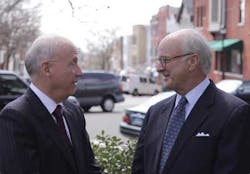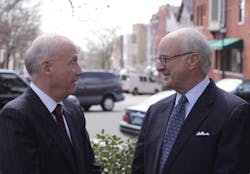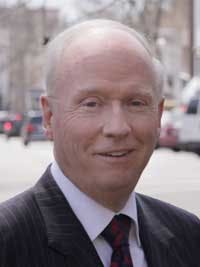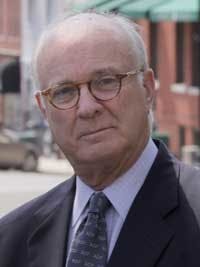EXCLUSIVE INTERVIEW WITH WILLIAM E. MACAULAY AND JOHN A. HILL OF FIRST RESERVE
All First Reserve photos, including cover photo, by Pascal Perich.
EDITOR’S NOTE: OGFJ recently met with Bill Macaulay and John Hill, co-founders of First Reserve, at their offices in Greenwich, Conn. on the occasion of the private equity firm’s 30th anniversary. Bill serves as chairman and CEO, and John is vice chairman. Don Stowers and Mitch Duffy, OGFJ’s editor and publisher, respectively, sat down with them to discuss private equity’s role in the oil and gas business. Here is a portion of that discussion.
OIL & GAS FINANCIAL JOURNAL: Back in 2006, Forbes magazine credited First Reserve with leading the private equity rush into the energy business. What is the status now? Has that so-called "rush" abated, or is it continuing?
BILL MACAULAY: No question, there’s more private equity coming into the energy sector within energy-specific funds as well as generalist funds. There’s definitely an increase in private equity funds in the sector. In terms of global M&A activity, energy is the biggest industry sector in the world – number one in activity. Yet when you look at it in terms of global sponsor M&A activity, it’s dead last. So that says a lot, right? There’s been a big increase in private equity coming into the business, but energy is still the most under-represented business in the world in terms of private equity.
JOHN HILL: First Reserve and its active controlled companies have invested over $5 billion of equity in platform investments and add-on acquisitions and mergers in 2012. There were about $350 billion in total private equity deals done in 2012, so that’s peanuts compared to the industry as a whole. But the number of new players is increasing. There are a lot of new start-ups in our business. I was just reading about one yesterday formed in Midland, Texas, that raised $400 million just to do business in the Permian Basin. Five years ago, there were probably only about four or five real players in the game. Today there are probably 10 or 12 new ones. Some are relatively small, but they’ve certainly grown in numbers.
OGFJ: Do you see yourselves as competing with other private equity groups for business?
MACAULAY: The industry is just so big, and even on the macro numbers only about 8% of the activity is private equity. That means, on the macro numbers, 92% of the time it’s not private equity. And that’s about right. Do we run into private equity? Yes, we do, but it’s probably less than 10% of the time.
HILL: I’d like to talk a little more about our investment strategy if I could. The vast majority of our deals are privately sourced. We don’t show up at a lot of auctions to buy things. After 30 years in the business, we have great industry relationships. If, say, Halliburton has something we want to buy, we can pick up the phone and call Halliburton and say, "We’d like to buy that." And try to structure a deal. These industry relationships are an important source of deals for us. They sort of minimize the times we run into other buyers. We create teams. We have teams that we’re interested in. We like to create opportunities with those teams. We do that by calling up the large E&P companies and large service companies. If there’s something they have that we’d like to own, we try to negotiate and we try to create a joint venture with them, as we did recently with Schlumberger.
OGFJ: Do you maintain an ongoing dialogue with these companies to keep abreast of possible opportunities?
MACAULAY: Well, yes, just to talk about business in general.
OGFJ: Thirty years ago, you two had the foresight to see that the oil and gas business was ripe for private equity investment. What leads you to believe that it is still a good investment?
MACAULAY: Well, we have arrived at that conclusion after 30 years in the business. We have several dozen portfolio companies, and we talk to people in the energy business every day. It’s what we do. Over time, you get a pretty good cross-section of views, and it’s given us a fair amount of insight into trends and what is likely to happen.
HILL: Also, I think we spotted early on the impact of some of these new technologies, not just in unconventional drilling but in technology that enabled us to see below the sub-salt in places such as offshore Brazil. We realized that these technologies were true game-changers and that significant new development would follow and provide us with many new opportunities for investment.
OGFJ: Are most of your portfolio companies associated with land-based or offshore drilling and production?
MACAULAY: Our single biggest position is the South Atlantic Basin. We have extensive positions there with four different companies. We’re in the Gulf of Mexico, as you might expect, but we’re also in offshore Brazil, offshore Angola, and offshore elsewhere in West Africa. In all, we have something like eight million offshore acres under lease and the equivalent of hundreds of offshore blocks. So our single biggest position would be offshore. Our second biggest position would be all the US onshore plays.
HILL: We also have positions in Europe and Asia and Australia, but these are smaller in size than the first two Bill mentioned.
OGFJ: That’s interesting because my impression has always been that onshore is more the province of private equity.
MACAULAY: Then you would be correct.
HILL: That’s where we started back in the ‘80s. We had a domestic focus and it was all onshore. At that time it was largely an industry going into bankruptcy or going into consolidation. The bottom had dropped out of the oil market, and our early investments were buying E&P properties and distressed companies that had filed for bankruptcy. They were good properties, but they just had too much debt. But that really was our focus early on. Our first investment outside the US was Highland Energy in 2000 in the North Sea. Of course we had investments on the service and equipment side of the industry, and that was global, but Highland Energy was our first investment in an E&P company outside the US.
At a glance: First ReserveFirst Reserve has focused exclusively on energy investing since 1983. With 30 years of industry insight, investment expertise, and operational excellence, the firm has cultivated a global network of relationships with investors and has raised more than USD $23 billion of aggregate capital since its inception. First Reserve has put both to work to complete more than 450 transactions (including platform investments and add-on acquisitions) on six continents. Today, the firm has the largest energy focused private equity investment team in the industry. Its portfolio companies operate in 50 countries and span the energy spectrum, including natural resources, equipment and services, midstream / downstream, and infrastructure, among others. First Reserve is headquartered in Greenwich, CT with offices in Houston, London, and Hong Kong. |
MACAULAY: The bulk of the private equity business is US-based. However, First Reserve is 50% non-US in terms of domicile – and more than that in terms of revenues. Most of the business is also onshore. We are atypical in that regard. Of the 30 shops – private equity shops – doing this, 29 are mainly focused on the US onshore industry. A couple of the 30 don’t fit that profile entirely, but the smaller ones are almost entirely focused on domestic onshore.
OGFJ: In your wildest imagination after starting the firm, did you ever think that 30 years later you would be in the position you’re in now?
MACAULAY: No. When we started out, I think the question was – how long we could last. Most of us at that time came from Oppenheimer and Meridien Capital. We were in the capital business; we were not in the energy business. And of the first five deals we did, two were energy deals and three were not. Taking over First Reserve, which was struggling, was deal number four. It wasn’t called this at the time, but First Reserve was a buyout business, a private equity business, and focused exclusively on energy.
HILL: There really weren’t any funds at that time, but the idea was just to find a deal and then find the money to make the deal.
MACAULAY: So this was the fourth deal. We backed into it, if you would. It started out as just another deal and evolved from there. We stopped doing the rest of the buyout business, and the two of us concentrated on this. The other three guys who worked with us went elsewhere.
HILL: Part of the issue was when we decided to make this our business there was a limitation on revenues, and it wouldn’t support five people. Our first fund was just $16.7 million, which tells you a little about how slow things were in those days. We were able to put together some investors – some insurance companies looking for yield, some corporate and public pension funds looking for an inflation hedge – but the ‘80s were very slow, no question about it.
MACAULAY: If you look back then, you could argue that we were a buyout firm or that we were an energy investor. Some people invest with us because we’re in the buyout business and others because we invest in energy. Obviously we do both. If you go back 30 years, there were a handful of firms that were doing buyouts.
OGFJ: Carl Icahn?
MACAULAY: Well, not so much. Several groups of people came out of Bear Stearns, and several came out of Oppenheimer, including myself. You had DLJ. You had Allen & Company. You had four or five firms doing buyouts with their own money. I ran the partners’ money doing buyouts at Oppenheimer. There were no funds. There were no institutional investors. It was a buyout business.
Thirty years ago, the only thing going on with energy investing was much more of this income product. So you had Trust Company of the West (TCW); a group that came out of Republic Bank in Dallas; Chase; Smith Barney; and this place, where the money was raised by First Boston. All were basically mezzanine.
HILL: They were all really a lending business more than anything else – not an equity fund.
MACAULAY: As you can see, the places that we just ticked off are all banks, or investment banks. So what it was doing was giving them another product. They were lending doing bank financing and the opportunity to do mezz. And that’s how it got going.
You also had a handful of people, probably fewer than 10, doing institutional partnerships. You had Petro-Lewis. You had American Quasar. Snyder had a big institutional partnership. When I was at Oppenheimer, I also ran Oppenheimer Energy and we owned 17% of Petro-Lewis and 20% of American Quasar, and we basically sold institutional partnership interests.
OGFJ: Did you see this as a vacuum that needed to be filled, a niche?
MACAULAY: Not so much. It was really wherever we saw a deal. So it started as a deal, then it evolved into recognizing there was this new market.
OGFJ: Was that deliberate? Were you then kind of focusing on energy going forward? Were those the type of deals you were seeking?
HILL: To be honest, we actually thought the energy space looked a whole lot more interesting in 1981-1982 at Meridian and in early 1983 than it turned out to be. That’s when oil was about $18 a barrel and gas was $10. There was a lot going on. There were new companies being created every day, both on the E&P side and the service and equipment side. It was quite exciting coming out of the ‘70s and going into the early ‘80s. But then gas went from $10.50 or whatever it was to about $2. Oil, which was around $36 in the mid-‘80s, dropped to about $10. So what we thought was going to be pretty interesting going in turned out to be a much longer slog than we expected. We turned out to be right, but the things we anticipated doing didn’t really take hold until the ‘90s.
MACAULAY: I used to say that we bought this place for a dollar, and we paid too much. It turned out to be a good buy, but we didn’t exactly step into a gold mine.
OGFJ: Your focus on energy has certainly paid off. With the oil and gas business doing so well right now, how much larger do you think the firm can get? Do you see any limits on growth?
MACAULAY: We’re pretty happy where we are. We essentially have two products – buyout funds and the infrastructure funds. The outlook is good for both products, and we’re pretty content where we are. Is there a platform you could build on? Yes. But we think there is plenty of room for growth in the two products we have.
HILL: I think the kind of growth we see is just to do more investments – adding more funds and doing more investments.
OGFJ: What impact has the so-called "Shale Revolution" had on First Reserve?
HILL: It’s certainly created some interesting opportunities to invest in the upstream energy space. Four, five, or six years ago, shale gas looked quite attractive. It also created some interesting midstream opportunities. So it’s had a huge impact just on the range of things you can look at onshore in the US versus 10 years ago. Today it’s a little more complicated because there’s too much shale gas, and it’s hard to find things that look attractive at this price. On the other hand, shale oil has really taken off and is looking attractive – not only on the E&P side, but on the infrastructure side. On the service and equipment side, you need more compressors, you need more pipe, you need more gathering systems. So it really has dramatically broadened the opportunities we have to look at.
OGFJ: Do you invest in smaller companies such as proppant suppliers and water management companies that are tied to fracturing and well completion activity in shale plays?
From left: Don Stowers, Mitch Duffy, John Hill, and Bill Macaulay talk private equity at the First Reserve office in Greenwich, Conn.
HILL: We could, we could. But so far we haven’t looked at companies like this that are involved in fracturing. We have looked at the companies that supply a lot of the service and activity that goes on around the actual fracturing operation.
MACAULAY: Generally speaking, our equity check size is a minimum of $100 million, which may exclude some of these companies. Our range is $100 million to about $500 million. As I mentioned, most of our clients are involved in the offshore oil and gas business, which tends to be a lot more capital intensive than onshore.
HILL: Back in the ‘80s, Bill and I just were not interested in exploration. It was high risk-high reward, and there was just too much risk for us. Today’s new technologies have enabled everyone to be much more confident about where you’re going and where you’re going to end up. That is true in shale plays and in the offshore sub-salt. Although these are much more expensive wells, the risks are much lower than in the old days.
MACAULAY: You also have to look at spreads and the number of shots you have on goal. You’re talking about wanting to have 15 shots on goal at $150 million to $200 million apiece. You’re getting into billions just on the exploration end, and by definition that becomes a drawback for a lot of the people in energy private equity. One well eats their fund. So you have to have a certain size, and you have to have the industry relationships to partner. In Brazil, for instance, all of our management teams are Brazilian or ex-Petrobras, so we partner with Petrobras.
HILL: One of the reasons we partner with companies is that to do certain types of deals, notably upstream, you need geologists and geophysicists in house who understand those things. To hire them away from industry these days is not cheap. You have to have a compelling reason to invest in upstream because of the high cost and the risk. Or you partner with someone and share these things.
MACAULAY: Let’s take shale gas as an example. Shale development is very important to the United States. The technology created an opportunity. On the other hand, the technology has now created a surplus and a lot less of an opportunity on the exploration side. But with that surplus, it’s created an opportunity on the midstream and transportation side – getting it from here to there. We also saw an opportunity when we bought TPC Group in Houston that makes petrochemicals using natural gas rather than oil. So the opportunities are really moving targets. So here we moved from upstream acreage opportunities to midstream opportunities, and you end up in the downstream sector doing something with the gas and electrics.
HILL: I think we may be moving into a situation where in the next 12 to 18 months there may be some distressed sales in the gas surplus area. That could be an interesting opportunity to buy some assets at more reasonable prices.
OGFJ: Are you talking about upstream?
HILL: Yes, upstream assets. We are seeing signs of that. There is no question that some companies are putting things on the market at prices far below what they paid for them. I think we’re in the early days of that, but that could present an opportunity for us within the next 12 months or so.
MACAULAY: The same opportunity moves global to other places in the world where you have shales, so you’re attempting to repeat that opportunity in other markets. Although you do learn the lesson that one of the wonderful things about the United States, about creativity and business in this country, is that you go elsewhere you run into problems with governments, you run into problems with land ownership, you find out there is no infrastructure, et cetera. But, in good old Midland, Texas, it’s pretty easy to go out there and get it done.
OGFJ: In addition to championing natural gas, Boone Pickens is known for his investments in renewable energy, particularly wind energy. You see a lot of wind turbines on the mesas and plains of West Texas. Is renewable energy part of your portfolio?
MACAULAY: We are investing in renewables with our infrastructure fund. We own solar in Europe and the United States. We own wind in Europe, the US, Canada, and Mexico. We do conventional garbage-to-energy, which gets renewed every day. So, yes, we do invest in renewables, but we tend to do it on long-term, existing, contracting businesses – wind farms with 20-year contracts, generally up and running, although we may expand on them. In the infrastructure fund, we’re looking for stable existing businesses, as opposed to building from the ground up. Renewable energy is a tough business.
One of the problems you have with renewables is that, by and large, they’re not economic, and thus they need subsidies. Subsidies come from government, and sometimes government giveth and sometimes government taketh. One government’s subsidiary is another government’s giveaway. Or sometimes another government’s trade complaint. So we shy away from the area with the exception of the infrastructure fund for existing businesses with 20-year contracts and so forth.
OGFJ: Let’s get back to your portfolio companies. Can you explain how closely you work with the management team and the back-and-forth between you and the company?
HILL: We absolutely work very closely with them. Initially, during the acquisition when we’re buying the company, we spend an awful lot of time with the management because we want to make sure we’re on the same page. We want to make sure they’re the team that we think we need, and a lot of our deals are built around that. Once we own the company, we really manage it through the board. We don’t take over any company that we don’t think might do an IPO someday, so you want to set up a real board culture that does the annual budget, does the annual capital spending programs, makes sure all the environmental issues and all the EHS issues are being carried out satisfactorily. Normally we’ll have two or three people from this firm on the board. Then we’ll have two or three other people we know, friends who know the industry and have something to offer that company, on the board as well.
OGFJ: Finally, what does First Reserve have to offer that a management team couldn’t get elsewhere?
HILL: I think we bring several things to the table. One, we have a deep sense of strategy and strategic opportunities. When we buy a company, we have a real belief that there is an opportunity to grow that company. There are companies we’ve bought, like CHC Helicopter Corporation, where we showed them opportunities they hadn’t even thought of, and they’d been in the business for 30 years. We think it’s our responsibility to our investors to think strategically about things such as where is this industry going, where is it going to be in five years. So we bring that strategic capability to the table.
Secondly, we bring good financial skills. We feel strongly about good balance sheets and proper capital structures. A lot of good oil and gas guys just don’t have that financial expertise. We bring access to capital, our capital. But we also have a capital markets group here that does all the capital markets work for our companies. So if they need to do a high yield bond offering, we take charge of that. We bring them in and work with them, we prepare the materials, and we set up the meetings and get it done. So we have this capital markets expertise that many other firms do not have. This is what we bring to the table.
OGFJ: Thank you both for taking time out of your day to talk with us, and happy 30th anniversary to you.




